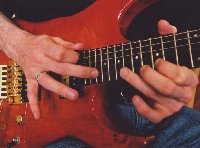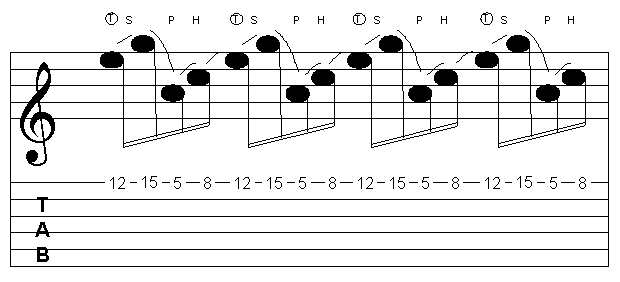Tapping
This tutorial was inspired by a question that I was
recently asked via the AllExperts website.
Recently, I was asked "how do you 'tap'? I've read about it,
especially in regards to Eddie Van Halen's style, but the actual technique
eludes me, although it sounds like it would be great to learn.
Any pointers? I'm totally clueless about this."
Tapping basically means using the picking hand on the fingerboard as
wall as the left. When you mention tapping, most people will think of
Eddie Van Halen, who did so much to popularise the technique, but his
style of tapping is just one of several variations.
 In its simplest form, tapping involves using a single finger from
your right hand (assuming you're right-handed, and that this is your
picking hand). If you play with a pick, then generally you'll find it
easiest to use your middle finger, as you can keep hold of the pick
between your thumb and index finger as normal, and this lets you switch
between picking and tapping with relative ease.
In its simplest form, tapping involves using a single finger from
your right hand (assuming you're right-handed, and that this is your
picking hand). If you play with a pick, then generally you'll find it
easiest to use your middle finger, as you can keep hold of the pick
between your thumb and index finger as normal, and this lets you switch
between picking and tapping with relative ease.
The style of tapping which occurs most often in rock music is one
where arpeggio patterns ra eplayed using a there-notes-per-string approach.
Normally, the range of an arpeggio would be too great to be able to play on
a single string - the left-hand fingers just can't reach that far.
However, when the right-hand is used, the stretch is easily playable.
Check out this example, where the right-hand is used to provide the
5th degree of an Am arpeggio. Note the use of a 'T' symbol in the tablature
to indicate which hand is being used - the 't' stands for 'tap' and indicates
that the right-hand should be used to tap the note.


This is a very useful pattern, and once you've mastered the basic technique
you can experiment with moving notes around to get different arpeggio patterns.
Have a look at this example, which starts on that Am arpeggio and then moves
through a whole progression.


Whilst those examples sound OK, they do run the risk of sounding a bit cliched.
The idea of playing triplet patterns with tapping like that has been used a lot,
so it's worthwhile taking a look at ways that we can use to make them sound a
bit more interesting.
The first way that we can may the pattens sound a bit more interesting is to
play a slight slur with the right hand. Instead of just tapping on a single note,
the right-hand finger can be slid up to a higher note after playing the initial tap.


Another thing you could try is to play the pattern as semiquavers instead of
triplets, with the tapped note being played more often, as in this example.


You can get some great sounds if you experiment with this idea and try to
introduce less a 'linear' approach to tapped patterns. One guitarist who does
this very well is Blues Saraceno. You will hear tapped patterns in his playing
quite often, but they aleays sound interesting as tends to avoid using very
basic phrasing.
Here we've looked at basic tapping. However, there are more advanced variations
of two-handed playing, where all four fingers of each hand are used on the neck.
One style of 8-finger tapping uses both hands working together, allowing you to
play relatively complex (and fast) patterns, with a smooth, legato feel. A superb
exponent of this is Jennifer Batten - track down a copy of her version of 'Flight of
the Bumblebee' to hear just what 8 fingers on the neck can achieve.
Another variation of two-handed tapping uses all 8 fingers, but heas the left and
right hands working independent of each other. This is similar to the way that the
left and right hands play separate lines on a piano keyboard. A great exponent of this
style is the bassist Stu Hamm - the highlight of his solo spot is Beethoven's 'Moonlight
Sonata' which is a great showcase of this technique.
Finally, despite the fact that so many of the references here have been to rock,
don't that tapping is a technique limited to this style of music alone. It crops up
in other styles of music, albeit less frequently. Jazz guitarist Stanley Jordan is a
great exponent of the style, who uses tapping to achieve smooth legato passages in
his soloing.
As with any guitar technique, take the time to master the basics, and then experiment
to see what you can achieve. Have fun.
Rate This Tutorial
How useful did you find this tutorial?
 In its simplest form, tapping involves using a single finger from
your right hand (assuming you're right-handed, and that this is your
picking hand). If you play with a pick, then generally you'll find it
easiest to use your middle finger, as you can keep hold of the pick
between your thumb and index finger as normal, and this lets you switch
between picking and tapping with relative ease.
In its simplest form, tapping involves using a single finger from
your right hand (assuming you're right-handed, and that this is your
picking hand). If you play with a pick, then generally you'll find it
easiest to use your middle finger, as you can keep hold of the pick
between your thumb and index finger as normal, and this lets you switch
between picking and tapping with relative ease.


